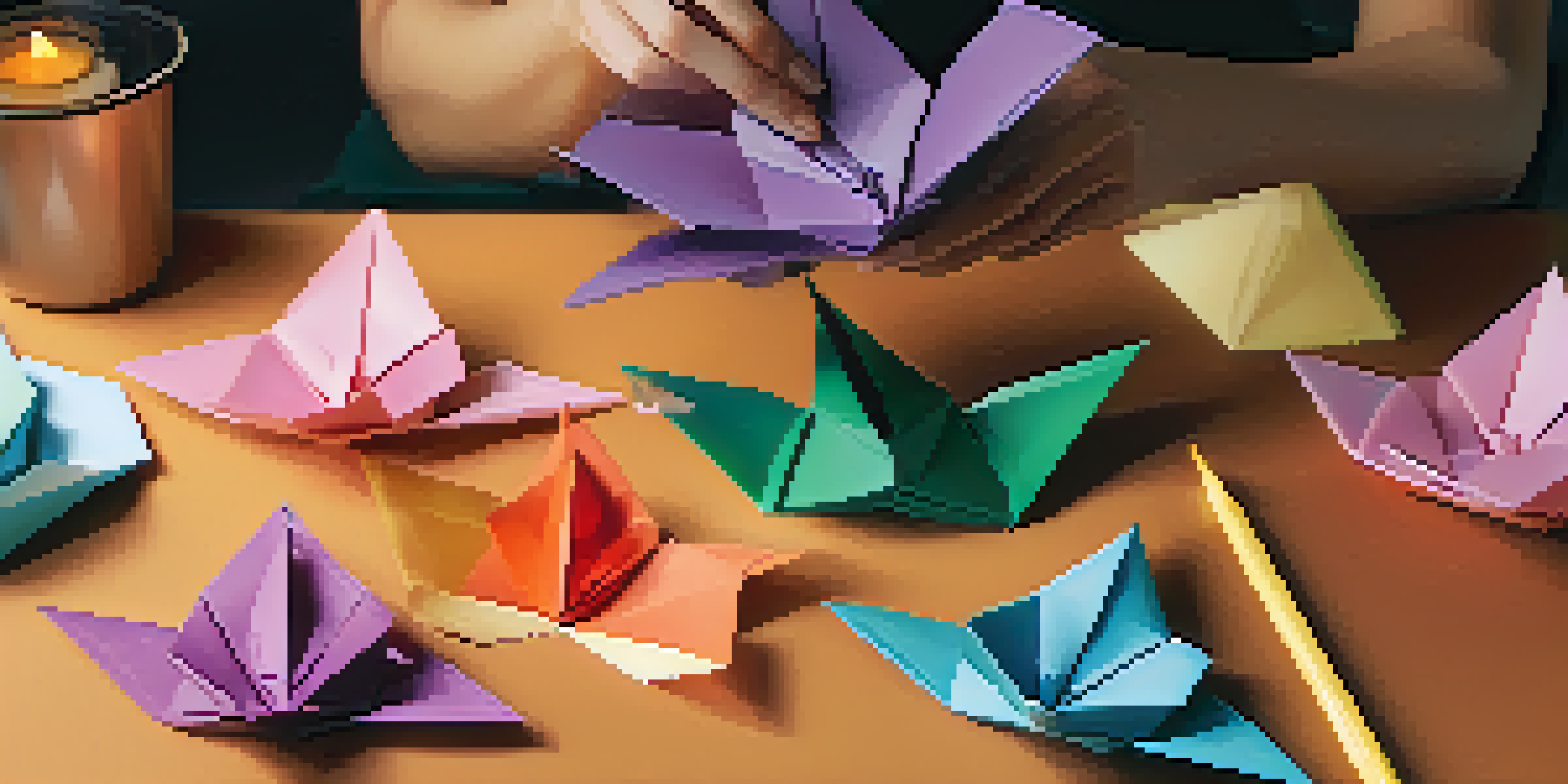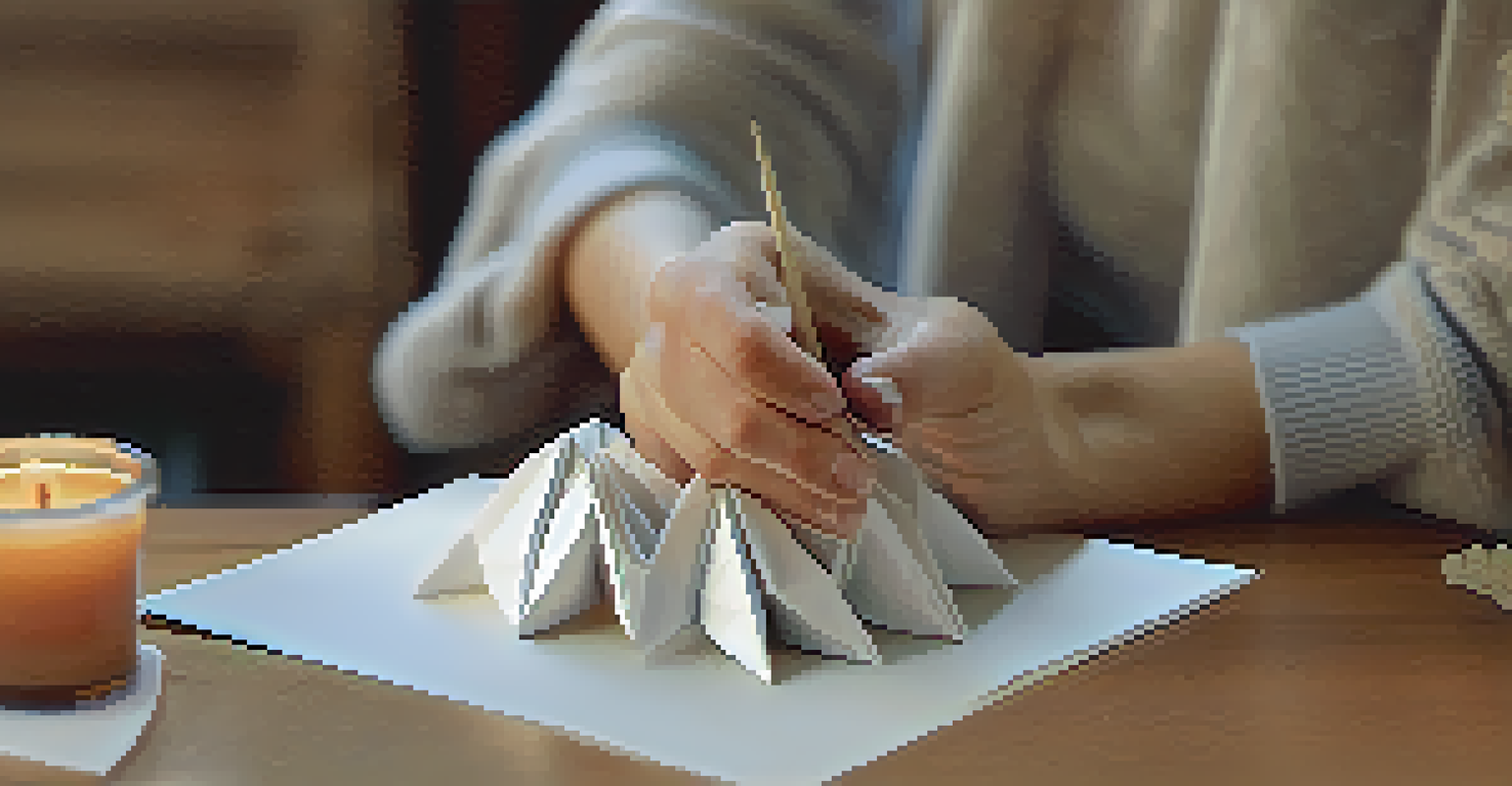Origami for Mindfulness: Techniques for Stress Relief

Understanding Mindfulness and Its Benefits
Mindfulness is the practice of being present in the moment, fully engaging with your thoughts and feelings without judgment. This approach can significantly reduce stress and anxiety, helping you to find calm in the chaos of daily life. By focusing your attention on the present, you can create a mental space that fosters clarity and emotional balance.
Mindfulness isn't difficult, we just need to remember to do it.
Incorporating mindfulness into your routine can lead to improved mental health, increased focus, and better overall well-being. Techniques like meditation, deep breathing, and even simple activities can enhance your mindfulness practice. One such engaging activity is origami, which combines creativity with concentration.
Origami, the art of paper folding, encourages you to slow down and immerse yourself in a tactile experience. As you focus on each fold, you naturally shift your attention away from stressors, creating a meditative state that promotes relaxation and mental clarity.
The Connection Between Origami and Mindfulness
Origami requires a level of concentration that can help quiet the mind, making it an ideal practice for mindfulness. Each fold demands attention, drawing you away from intrusive thoughts and allowing you to engage fully with the present moment. This focus fosters a sense of accomplishment as you transform a simple piece of paper into something beautiful.

Furthermore, the repetitive and rhythmic motions involved in origami can have a calming effect on your mind and body. Like knitting or painting, the act of folding paper can serve as a form of meditation, helping you to establish a flow state. This flow can improve your emotional resilience, making it easier to manage stress.
Mindfulness Reduces Stress Effectively
Practicing mindfulness through activities like origami can significantly lower stress and anxiety.
In essence, the process of creating origami not only engages your hands but also your mind, leading to a harmonious balance between creativity and mindfulness. As you immerse yourself in this practice, you might find that your worries begin to melt away, leaving room for peace and clarity.
Simple Origami Techniques for Beginners
If you're new to origami, starting with simple designs can make the experience enjoyable and less overwhelming. Basic projects like the origami crane or a paper boat are great first steps. These designs allow you to practice fundamental folding techniques while producing charming results that can boost your confidence.
Creativity takes courage.
As you become comfortable with simple folds, you can gradually tackle more complex designs. This progression not only enhances your skills but also keeps your mind engaged in a positive way. Each completed piece serves as a reminder of your focus and creativity, reinforcing the mindfulness practice.
Remember, the goal of origami is not perfection but rather the enjoyment of the process. Embrace the mistakes and learn from them; this approach mirrors the essence of mindfulness, where acceptance is key. Celebrate each fold as a step toward relaxation and self-expression.
Creating a Mindful Origami Space
To maximize the benefits of origami for mindfulness, creating a dedicated space for your practice is essential. Choose a quiet area free from distractions where you can fully immerse yourself in the experience. A clean, organized space can help set the tone for relaxation and focus.
Consider adding elements that enhance the atmosphere, such as soft lighting, calming music, or even a scented candle. These sensory details can help signal to your mind that it's time to unwind and engage in your origami practice. The more inviting your space, the more likely you are to return to it regularly.
Origami Enhances Focus and Creativity
Engaging in origami fosters concentration and a sense of accomplishment, enhancing both creativity and mental clarity.
Finally, make this space personal and reflective of your style. Surrounding yourself with items that inspire you can enhance your creative flow. This intentional setup will not only help you focus on origami but also create a sanctuary for mindfulness in your busy life.
Integrating Mindfulness into Your Origami Practice
As you engage in origami, take the time to breathe deeply and center your thoughts before you start. Setting an intention for your practice—such as relaxation, creativity, or focus—can enhance the mindfulness experience. Each time you fold, remind yourself of your intention, drawing your attention back to the present moment.
Throughout the process, pay attention to the sensations of the paper in your hands, the sound of each fold, and the visual beauty of your creation. Allow yourself to fully experience these aspects, which can cultivate a deeper connection to the art of origami. This heightened awareness can transform your practice into a genuine mindfulness exercise.
As you fold, let go of any judgment regarding the final product. Instead, appreciate the journey of creation and the mindfulness it brings. Each piece you create becomes a reflection of your momentary experience, capturing the essence of your thoughts and feelings.
The Psychological Benefits of Origami for Stress Relief
Research indicates that engaging in creative activities like origami can significantly reduce stress levels. The focus required can help distract you from anxiety and negative thoughts, acting as a form of mental therapy. This therapeutic aspect allows you to channel your emotions into a tangible form, providing a sense of control.
Moreover, completing an origami project can produce feelings of accomplishment and joy, contributing to a more positive mindset. As you watch your paper transform, you experience a sense of progress that can uplift your spirits. This boost in mood can be particularly beneficial during challenging times.
Create a Dedicated Mindful Space
Establishing a serene, personal space for origami practice can amplify the mindfulness experience and promote relaxation.
Incorporating origami into your self-care routine can be a powerful tool for emotional regulation. By turning your attention to the folds and creases, you cultivate a practice that promotes healing and resilience, helping you navigate life’s ups and downs with a calmer demeanor.
Conclusion: Embracing Origami for Mindfulness
Incorporating origami into your mindfulness practice can be a fulfilling way to relieve stress and enhance your overall well-being. The act of folding paper serves as a gentle reminder to slow down, focus, and appreciate the present moment. Each creation becomes a testament to your journey, showcasing the beauty of imperfection.
By dedicating time to this art form, you not only develop your skills but also nurture your mental health. The combination of creativity and mindfulness can create a powerful synergy that supports emotional balance. Whether you're a seasoned artist or a curious beginner, origami offers a meaningful path to self-discovery.

So why not give it a try? Grab a piece of paper, find a quiet corner, and let the folds guide you to a more mindful state. With each crease, you might just find a little more peace in your day.